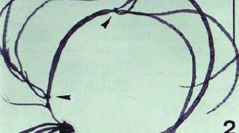

 Cryptogamie, Algologie
23 (1) - Pages 39-49
Cryptogamie, Algologie
23 (1) - Pages 39-49Three collections of Paralemanea from Central Mexico included two species. Paralemanea mexicana is large (length ≥ 4.0 cm; diameter > 400 µm) and generally branched (≥ 40 % of plants branched), with whorled branches, of first to second order. Paralemanea annulata is small (length < 5.0 cm ; diameter < 500 pm), generally unbranched (≤ 5 % of plants branched), with branches of first order. Spermatangial sori contained obovoid spermatangia, formed from cells of the outer cortical layers, extending above the thallus surface. Carpogonial branches are described for the first time in P. mexicana. They develop on lateral filaments at nodes or internodes and have ovoid to globular cells, abundantly branched at the basal portion, penetrating the cortex towards the thallus surface. Carposporophytes are sessile on the inner portion of the cortex and produce carpospores in chains of up to twelve. The ‘Chantransia' stage was observed in P. mexicana. Paralemanea annulata is described for the first time from Mexico and P. mexicana is endemic from this country. Both species were collected in cold (temperature 12-16°C), acidic (pH 5.5-6.0), shallow (depth 1-60 cm) and moderate to fast flowing waters (> 35 cm s-1), in shaded or partly shaded river segments, on rocky substrata (mostly bedrock).
Batrachospermales, distribution, freshwater algae, Lemaneaceae, Mexico, Paralemanea, Rhodophyta, taxonomy